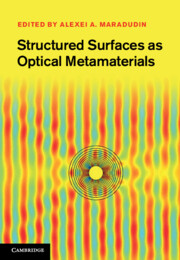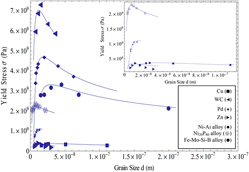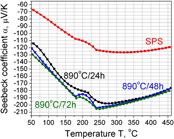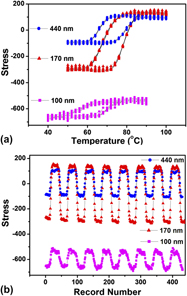Refine search
Actions for selected content:
106100 results in Materials Science
Interpreting the softening of nanomaterials through gradient plasticity
-
- Journal:
- Journal of Materials Research / Volume 26 / Issue 11 / 14 June 2011
- Published online by Cambridge University Press:
- 10 June 2011, pp. 1399-1405
- Print publication:
- 14 June 2011
-
- Article
- Export citation
Elastic anomaly and internal friction of Ba0.5Sr0.5Co0.8Fe0.2O3-δ and La0.58Sr0.4Co0.2Fe0.8O3-δ
-
- Journal:
- Journal of Materials Research / Volume 26 / Issue 11 / 14 June 2011
- Published online by Cambridge University Press:
- 10 June 2011, pp. 1388-1391
- Print publication:
- 14 June 2011
-
- Article
- Export citation
Threading defect elimination in GaN nanowires
-
- Journal:
- Journal of Materials Research / Volume 26 / Issue 17 / 14 September 2011
- Published online by Cambridge University Press:
- 08 June 2011, pp. 2293-2298
- Print publication:
- 14 September 2011
-
- Article
- Export citation
Mild hydrothermal synthesis of γ-MnO2 nanostructures and their phase transformation to α-MnO2 nanowires
-
- Journal:
- Journal of Materials Research / Volume 26 / Issue 17 / 14 September 2011
- Published online by Cambridge University Press:
- 07 June 2011, pp. 2268-2275
- Print publication:
- 14 September 2011
-
- Article
- Export citation
Enhanced electrical conductivity in Si80Ge20B0.6 alloys with Er addition prepared by spark plasma sintering
-
- Journal:
- Journal of Materials Research / Volume 26 / Issue 15 / 14 August 2011
- Published online by Cambridge University Press:
- 07 June 2011, pp. 1879-1885
- Print publication:
- 14 August 2011
-
- Article
- Export citation
Continuum modeling of large-strain deformation modes in gold nanowires
-
- Journal:
- Journal of Materials Research / Volume 26 / Issue 17 / 14 September 2011
- Published online by Cambridge University Press:
- 07 June 2011, pp. 2286-2292
- Print publication:
- 14 September 2011
-
- Article
- Export citation
Thermoelectric properties of spark plasma sintered composites based on TiNiSn half-Heusler alloys
-
- Journal:
- Journal of Materials Research / Volume 26 / Issue 15 / 14 August 2011
- Published online by Cambridge University Press:
- 07 June 2011, pp. 1919-1924
- Print publication:
- 14 August 2011
-
- Article
- Export citation
Phase diagram study of the Si–P system in Si-rich region
-
- Journal:
- Journal of Materials Research / Volume 26 / Issue 12 / 28 June 2011
- Published online by Cambridge University Press:
- 07 June 2011, pp. 1494-1503
- Print publication:
- 28 June 2011
-
- Article
- Export citation
Towards an integrated materials characterization toolbox
-
- Journal:
- Journal of Materials Research / Volume 26 / Issue 11 / 14 June 2011
- Published online by Cambridge University Press:
- 07 June 2011, pp. 1341-1383
- Print publication:
- 14 June 2011
-
- Article
-
- You have access
- HTML
- Export citation
Artificially nanostructured n-type SiGe bulk thermoelectrics through plasma enhanced growth of alloy nanoparticles from the gas phase
-
- Journal:
- Journal of Materials Research / Volume 26 / Issue 15 / 14 August 2011
- Published online by Cambridge University Press:
- 07 June 2011, pp. 1872-1878
- Print publication:
- 14 August 2011
-
- Article
- Export citation
Size effects on stress relaxation across the metal–insulator transition in VO2 thin films
-
- Journal:
- Journal of Materials Research / Volume 26 / Issue 11 / 14 June 2011
- Published online by Cambridge University Press:
- 03 June 2011, pp. 1384-1387
- Print publication:
- 14 June 2011
-
- Article
- Export citation
Thermoelectric nanocomposite from the metastable void filling in caged skutterudite
-
- Journal:
- Journal of Materials Research / Volume 26 / Issue 15 / 14 August 2011
- Published online by Cambridge University Press:
- 03 June 2011, pp. 1848-1856
- Print publication:
- 14 August 2011
-
- Article
- Export citation
Synthesis of hollow porous nanospheres of hydroxyl titanium oxalate and their topotactic conversion to anatase titania
-
- Journal:
- Journal of Materials Research / Volume 26 / Issue 12 / 28 June 2011
- Published online by Cambridge University Press:
- 03 June 2011, pp. 1545-1551
- Print publication:
- 28 June 2011
-
- Article
- Export citation
Influence of p- and n-type doping on the transport properties of the Nowotny chimney-ladder compounds RuAl2 and RuGa2
-
- Journal:
- Journal of Materials Research / Volume 26 / Issue 15 / 14 August 2011
- Published online by Cambridge University Press:
- 03 June 2011, pp. 1907-1912
- Print publication:
- 14 August 2011
-
- Article
- Export citation
Thermoelectric oxide modules tested in a solar cavity-receiver
-
- Journal:
- Journal of Materials Research / Volume 26 / Issue 15 / 14 August 2011
- Published online by Cambridge University Press:
- 03 June 2011, pp. 1975-1982
- Print publication:
- 14 August 2011
-
- Article
- Export citation
Transport properties and microstructure of indium-added cobalt–antimony-based skutterudites
-
- Journal:
- Journal of Materials Research / Volume 26 / Issue 15 / 14 August 2011
- Published online by Cambridge University Press:
- 03 June 2011, pp. 1820-1826
- Print publication:
- 14 August 2011
-
- Article
- Export citation
Nanoindentation strain-rate jump tests for determining the local strain-rate sensitivity in nanocrystalline Ni and ultrafine-grained Al
-
- Journal:
- Journal of Materials Research / Volume 26 / Issue 11 / 14 June 2011
- Published online by Cambridge University Press:
- 02 June 2011, pp. 1421-1430
- Print publication:
- 14 June 2011
-
- Article
- Export citation
A general relation for contact stiffness including adhesion in indentation analysis
-
- Journal:
- Journal of Materials Research / Volume 26 / Issue 11 / 14 June 2011
- Published online by Cambridge University Press:
- 02 June 2011, pp. 1406-1413
- Print publication:
- 14 June 2011
-
- Article
- Export citation

Structured Surfaces as Optical Metamaterials
-
- Published online:
- 01 June 2011
- Print publication:
- 21 April 2011
DOE adds five program areas to ARPA-E funding opportunities
-
- Journal:
- MRS Bulletin / Volume 36 / Issue 6 / June 2011
- Published online by Cambridge University Press:
- 10 June 2011, pp. 412-413
- Print publication:
- June 2011
-
- Article
-
- You have access
- HTML
- Export citation


















